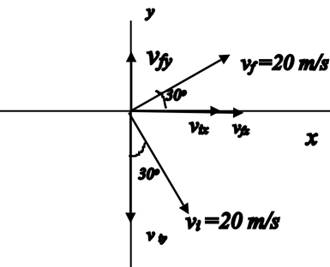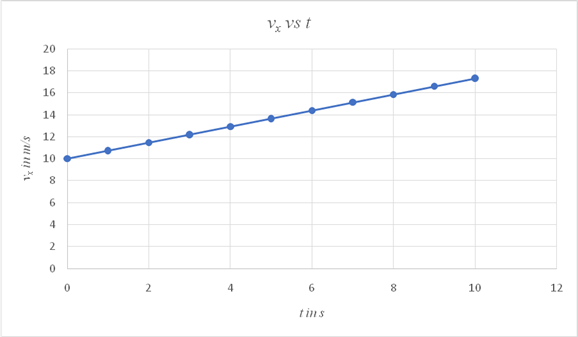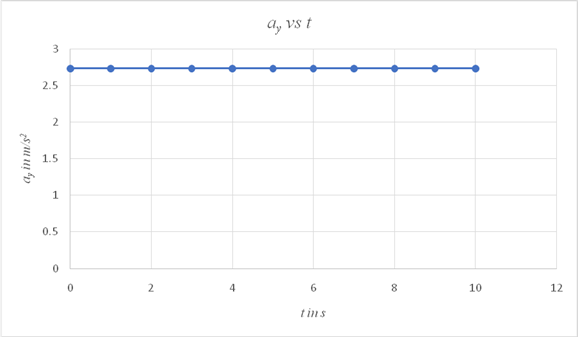
Concept explainers
(i) The x component of the velocity versus time
(ii) The y component of the velocity versus time
(iii) The y component of the acceleration versus time.
Explanation of Solution
Given info:
Magnitude of the initial velocity
Angle made by vi with x- axis
Magnitude of the final velocity
Angle made by vf with x axis
Time interval during which the velocity changes
Formula used:
The components of the velocity vectors along the x and the y directions are given by,
The change in velocity along the x and the y directions is given by,
The components of the acceleration along the x and y directions are given by,
The equation to determine the variation of
The equation to determine the variation of
Calculation:
Resolve the vectors vi and vf along the x and the y axes. This is shown in the diagram below.

The components of the velocity vector vi are directed along +x and-y axes, hence the y component is assigned a negative sign. Calculate the magnitude of the components substituting the values of the variables in the equation,
The components of the final velocity vector vf are directed along the +x and +y directions, hence the components are positive. Calculate the magnitude of the components of the vector vf using the values of the variables.
Calculate the change in velocity along the x and the y directions.
Calculate the components of the acceleration along the x and the y directions.
Using the values of vix and ax in the equation
Plot a graph showing the variation of vx with time.
| t in s | vxin m/s |
| 0 | 10 |
| 1 | 10.732 |
| 2 | 11.464 |
| 3 | 12.196 |
| 4 | 12.928 |
| 5 | 13.66 |
| 6 | 14.392 |
| 7 | 15.124 |
| 8 | 15.856 |
| 9 | 16.588 |
| 10 | 17.32 |

Using the values of viy and ay in the equation
Use the equation in a spread sheet and plot the graph showing the variation of vy with time t.
| X-Values | Y-Values |
| 0 | -17.32 |
| 1 | -14.588 |
| 2 | -11.856 |
| 3 | -9.124 |
| 4 | -6.392 |
| 5 | -3.66 |
| 6 | -0.928 |
| 7 | 1.804 |
| 8 | 4.536 |
| 9 | 7.268 |
| 10 | 10 |

The y component of the acceleration ay is independent of time, since the object's acceleration remains constant during the time interval.
Plot a graph showing the variation of ay with time t.
| t in s | ayin m/s2 |
| 0 | 2.732 |
| 1 | 2.732 |
| 2 | 2.732 |
| 3 | 2.732 |
| 4 | 2.732 |
| 5 | 2.732 |
| 6 | 2.732 |
| 7 | 2.732 |
| 8 | 2.732 |
| 9 | 2.732 |
| 10 | 2.732 |

Conclusion:
The graph showing the variation of vx with time is linear and the value increases from 10 m/s to 17.32 m/s at the end of 10 s.
The graph showing the variation of vy with time is also linear and its value increases from -17.32 m/s to reach a value of 10 m/s at the end of 10 s.
The graph showing the variation of ay with time is a straight line parallel to the time axis, showing that its value is invariant with time.
Thus all the results are consistent with an object moving with a constant acceleration during the time interval of 10s.
Want to see more full solutions like this?
Chapter 3 Solutions
COLLEGE PHYSICS
- A Lockheed Martin F-35 II lighting jet takes off from an aircraft carrier with a runway length of 90 m and a takeoff speed 70 m/s at the end of the runway. Jets are catapulted into airspace from the deck of an aircraft carrier with two sources of propulsion: the jet propulsion and the catapult. At the point of leaving the deck of the aircraft carrier, the F-35’s acceleration decreases to a constant acceleration of 5.0m/s2 at 30 with respect to the horizontal. (a) What is the initial acceleration of the F-35 on the deck of the aircraft carrier to make it airborne? (b) Write the position and velocity of the F-35 in unit vector notation from the point it leaves the deck of the aircraft carrier. (c) At what altitude is the fighter 5.0 s after it leaves the deck of the aircraft carrier? (d) What is its velocity and speed at this time? (e) How far has it traveled horizontally?arrow_forwardThe top marathon runners complete the race in around 2 hours, so such an elite marathoners average speed is around 13.1 mph. To calculate a runners average velocity in a marathon, we would have to know the displacement, which means knowing the particular course. If the magnitude of the runners displacement is 20 mi over course A and 12 mi over course B, find the magnitude of the average velocity for each course (Fig. 2.14) and compare your results to the elite marathon average speed.arrow_forwardFind the following for path A in Figure 3.54: (a) the total distance traveled, and (b) the magnitude and direction of the displacement from start to finish.arrow_forward
- Plus and minus signs are used in one-dimensional motion to indicate direction. What is the sign of an acceleration that reduces the magnitude of a negative velocity? Of a positive velocity?arrow_forwardAstronauts on a distant planet toss a rock into the air. With the aid of a camera that takes pictures at a steady rate, they record the rocks height as a function of time as given in the following table, (a) Find the rocks average velocity in the time interval between each measurement and the next, (b) Using these average velocities to approximate instantaneous velocities at the midpoints of the lime intervals, make a graph of velocity as a function of time, (c) Does the rock move with constant acceleration? If so, plot a straight line of best fit on the graph and calculate its slope to find the acceleration.arrow_forwardA celebrated Mark Twain story has motivated contestants in the Calaveras County Jumping Frog Jubilee, where frog jumps as long as 2.2 m have been recorded. If a frog jumps 2.2 m and the launch angle is 45, find (a) the frogs launch speed and (b) the time the frog spends in the air. Ignore air resistance.arrow_forward
- If the velocity of an object is nonzero, can its acceleration be zero?Give an example if your answer is yes; explain why not if your answer is no.arrow_forward• 2. An arrow is shot upward from the top of a 740 ft building with an initial velocity of 68 ft/s. a. State the arrow's position function. b. State the velocity function. c. State the acceleration. d. Find the average velocity of the arrow between 2 and 4 seconds. e. Find the maximum height reached by the arrow, f. What is the instantaneous velocity and acceleration at 5 seconds. g. The time when its strikes the ground - h. The final velocity when it hits the ground. • i. The time and velocity when it passes 520 ft from the ground.arrow_forwardExample 3 • A particle moves along the x-axis so that at any t≥ 0 its velocity is given by v(t) = t² - 16t+4. What is the velocity of the particle when its acceleration is zero.arrow_forward
- Textbook 3 R If a rock is dropped from a height of 215 ft, its poistion t seconds after it is dropped until it hits the ground is given by the function s(t) = -16t² + 215. Round values below to 3 decimal places. How long does it take the rock to hit the ground? to Find the average velocity of the rock from when it is released until when it hits the ground. feet per second 5 What time after the rock is thrown will its instantaneous velocity be equal to its average velcity? (Apply the Mean Value Theorem) % Submit Question Videos [+] 6 Question Help: Message instructor D Post to forum F5 7 & H F6 TYU seconds 100 J Q Search 8 seconds after it is thrown * F7 I 9 ( V FB O O P KT L M F10 ► 11 F11 W F12 M BACKSPACE ENTER PAUSE INS PG DN DEL HOME SCR LOCK END PG UP PRT SCRN NUM LOCK 7arrow_forwardLinear Motion Free Fall for Rookie 1= 2.04 s Ja 20.4 m t-0, yo -0 • A stone is thrown from the top of a building with an initial velocity of 20.0 m/s straight upward, at an initial height of 50.0 m above the ground. The stone just misses the edge of the roof on the its way down. Determine • (a) the time needed for the stone to reach its maximum height. • (b) the maximum height. • (c) the time needed for the stone to return to the height from which it was thrown and the velocity of the stone at that instant. " - 20.0 m/s != 4.08 s y=0 -20.0 m/s I- 5.00 s y=-22.5 m V=-29.0 m/s 50.0 m • (d) the time needed for the stone to reach the ground • (e) the velocity and position of the stone at t= 5.00s Jan. 1= 5.83 y-50.0 m P-37.1 m/sarrow_forward1-10. A gardener walks in a flower garden as illustrated in the figure below. a.)What distance does the gardener travel? b.)What is the gardener's displacement? Distance (mctors)arrow_forward
 Physics for Scientists and Engineers, Technology ...PhysicsISBN:9781305116399Author:Raymond A. Serway, John W. JewettPublisher:Cengage Learning
Physics for Scientists and Engineers, Technology ...PhysicsISBN:9781305116399Author:Raymond A. Serway, John W. JewettPublisher:Cengage Learning College PhysicsPhysicsISBN:9781938168000Author:Paul Peter Urone, Roger HinrichsPublisher:OpenStax College
College PhysicsPhysicsISBN:9781938168000Author:Paul Peter Urone, Roger HinrichsPublisher:OpenStax College Principles of Physics: A Calculus-Based TextPhysicsISBN:9781133104261Author:Raymond A. Serway, John W. JewettPublisher:Cengage Learning
Principles of Physics: A Calculus-Based TextPhysicsISBN:9781133104261Author:Raymond A. Serway, John W. JewettPublisher:Cengage Learning Physics for Scientists and Engineers: Foundations...PhysicsISBN:9781133939146Author:Katz, Debora M.Publisher:Cengage Learning
Physics for Scientists and Engineers: Foundations...PhysicsISBN:9781133939146Author:Katz, Debora M.Publisher:Cengage Learning University Physics Volume 1PhysicsISBN:9781938168277Author:William Moebs, Samuel J. Ling, Jeff SannyPublisher:OpenStax - Rice University
University Physics Volume 1PhysicsISBN:9781938168277Author:William Moebs, Samuel J. Ling, Jeff SannyPublisher:OpenStax - Rice University Glencoe Physics: Principles and Problems, Student...PhysicsISBN:9780078807213Author:Paul W. ZitzewitzPublisher:Glencoe/McGraw-Hill
Glencoe Physics: Principles and Problems, Student...PhysicsISBN:9780078807213Author:Paul W. ZitzewitzPublisher:Glencoe/McGraw-Hill





